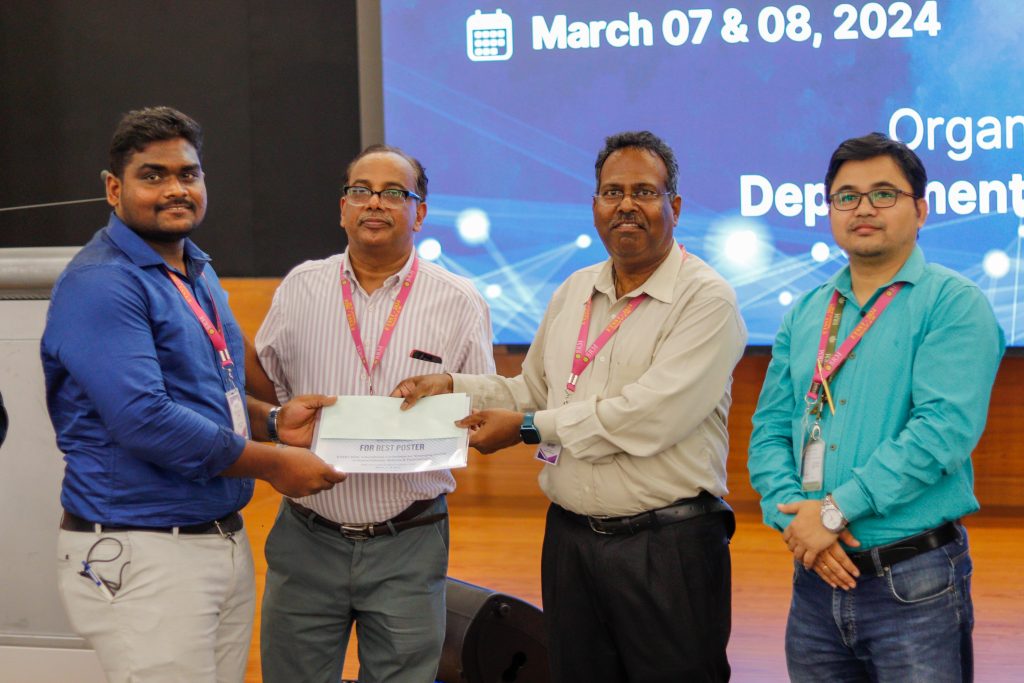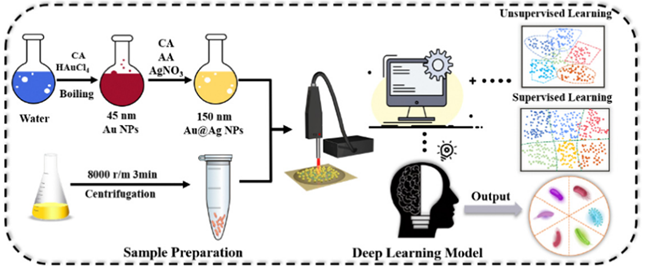Recent News
- ETSST 2024: Exploring the Next Frontier in Supra Molecular Technology March 13, 2024

The Department of Chemistry at SRM University-AP has taken a significant initiative by organising an International Conference on “Emerging Trends in Supramolecular Science and Technology” (ETSST-2024) on March 07 and 08, 2024. This two-day conference brought together some of the most renowned and accomplished national and international intellectuals in the field of chemistry, who will share their insights and expertise on the latest advancements, emerging trends, and future prospects in the domain of supramolecular science and technology. The conference promises to be a great platform for researchers, scientists, academicians, and students to exchange ideas, network, and collaborate towards making breakthrough contributions in the field.
The conference marked the presence of academic stalwarts from institutes of national and international repute who expounded on the relevance of the conference and discoursed upon the various topics.
The event also featured the unveiling of the abstract book compiled by the department. Vice Chancellor, Prof. Manoj K Arora; Registrar, Dr R Premkumar; the Associate Dean- Science, Prof. Jayaseelan Murugaiyan; Chairman and Convenor ETSST-2024, Prof. C Pulla Rao; HoD- Chemistry, Dr Pardha Saradhi Maram; Dr Seema Rani and Dr Balaji Babu, Assistant Professors, Department of Chemistry, SRM AP bore witness to this momentous occasion.
At its core, the essence of this conference lay in its audacious objective – to unravel the enigmatic world of supramolecular science, where chemistry transcends the boundaries of individual molecules. It is a domain where complexity breeds innovation, and practical applications pave the way for unprecedented advancements in engineering and technology.
As the curtains drew to a close on this grand spectacle, the echoes of inspiration and collaboration continued to reverberate within the hearts and minds of all who were part of this transformative experience. The bonds forged and the knowledge shared during ETSST-2024 will forever shape the trajectory of supramolecular science and technology.
Continue reading →



- Revolutionising Sustainable Living: A Discourse on Green Chemistry February 18, 2024

In a world of fast-escalating environmental challenges, the idea of sustainability comes as a ray of hope for a safe and sound future. The present scenario calls for the kind of development that meets the needs of the present without compromising the future. In this regard, the Department of Chemistry at SRM University-AP organised a colloquium, that aimed to provide students with a comprehensive understanding of the concepts of Green Chemistry.
Dr Ram Mohan, an expert in the field of Green Chemistry and a renowned academician at the Department of Chemistry, Illinois Wesleyan University, delivered a lecture on the topic “Better Living Through Green Chemistry: An Introduction to Toxic Molecules”. Dr Mohan spoke elaborately on the grave dangers of toxic molecules and their adverse effects on the environment and human health. He raised awareness about the critical role of green chemistry in reducing the usage of such harmful molecules and replacing them with environmentally safe alternatives.
Dr Mohan also conducted workshops on “Better Living Through Green Chemistry”, as a continuation of his lecture. During the workshop, he quoted several case studies that showcased the benefits of using environmentally safe processes and chemicals in industry. These case studies demonstrated how the practice of green chemistry can lead to the development of numerous Eco-friendly processes and chemicals that have greatly improved human life and reduced environmental impact.
Continue reading → - ChemZeal 2: An Outreach Initiative by the Dept. of Chemistry December 20, 2023

The Department of Chemistry at SRM University-AP organised an academic colloquium called ChemZeal 2 on December 02, 2023. The event aimed to promote the Department and its research among undergraduate and graduate students from various colleges. It also provided a platform for students to interact with chemistry enthusiasts and learn about the latest advancements and research in the field.
ChemZeal 2 featured a lecture by academic stalwart, Prof. U V Varadaraju on Solid-State Materials in Chemistry from the Department of Chemistry, IIT Madras. Prof. Varadaraju also spoke about various aspects of the field, including research, career paths, higher studies, and job opportunities in the industry.
The welcome note was given by the Department Head, Dr Pardha Saradhi Maram, while Vice-Chancellor Prof. Manoj K Arora and Prof. Jayaseelan Murugaiyan, Associate Dean in-charge (Science), also addressed the gathering with their valuable inputs. The event also included an interactive session with the guest speaker, where faculty and students could interact and get expert insights.
ChemZeal 2 also featured a talent test for over 320+ students from different colleges, with prizes awarded to the top three winners. The event was designed to attract students to pursue higher education and research in the field of Chemistry and provided a platform for BSc/MSc/PhD students to showcase their research and interact with potential candidates.
The event organisers – Dr Sabyasachi Chakrabortty (Convenor) & Dr J P Raja Pandiyan (Co-convenor) helped culminate the outreach activity with a campus tour, where attendees could witness state-of-the-art facilities, high-end research labs, and futuristic technology.
- Raman Signals Emitted by Pathogenic Vibrio Microorganisms and Purine Metabolites: A Comprehensive Analysis June 1, 2023
Dr Rajapandiyan Panneerselvam, Assistant Professor, Department of Chemistry, and his team have developed a method using a portable Raman spectrometer to quickly identify six common pathogenic Vibrio species that can contaminate seafood. His latest research paper Intelligent convolution neural network-assisted SERS to realise highly accurate identification of six pathogenic Vibrio, has been published in the Q1 Nature Index journal Chemical Communications, having an Impact Factor of 6.0.
 By using gold-silver nanoparticles, the study was able to accurately detect these harmful microorganisms. The new deep learning model called a convolutional neural network (CNN), outperformed traditional machine learning methods with a classification accuracy of 99.7%. The entire identification process only took 15 minutes. The researchers also discovered that the Raman signals emitted by Vibrio species are similar to signals from certain substances found in purine degradation, such as uric acid and adenine. This knowledge helps them explain why different Vibrio species produce slightly different Raman signals. Overall, the CNN-assisted Raman spectroscopy method offers a fast and accurate way to diagnose and identify harmful microorganisms responsible for food contamination.
By using gold-silver nanoparticles, the study was able to accurately detect these harmful microorganisms. The new deep learning model called a convolutional neural network (CNN), outperformed traditional machine learning methods with a classification accuracy of 99.7%. The entire identification process only took 15 minutes. The researchers also discovered that the Raman signals emitted by Vibrio species are similar to signals from certain substances found in purine degradation, such as uric acid and adenine. This knowledge helps them explain why different Vibrio species produce slightly different Raman signals. Overall, the CNN-assisted Raman spectroscopy method offers a fast and accurate way to diagnose and identify harmful microorganisms responsible for food contamination.Abstract
The utilisation of label-free Surface-Enhanced Raman Spectroscopy (SERS) technology enabled a comprehensive analysis of the connection between Raman signals emitted by pathogenic Vibrio microorganisms and purine metabolites. Through extensive research, a sophisticated Convolutional Neural Network (CNN) model was developed, demonstrating exceptional performance with an accuracy rate of 99.7% in the rapid identification of six common pathogenic Vibrio species within a mere 15-minute timeframe. This breakthrough offers a groundbreaking approach to pathogen identification, introducing a novel and efficient method to the field.
Practical Implementation of the Research
 The practical implementation of label-free SERS technology combined with a deep learning CNN model enables rapid and accurate identification of pathogenic Vibrio microorganisms. This has important social implications, including improving public health and safety by quickly identifying and controlling outbreaks, enhancing food safety measures, and enabling real-time pathogen detection in resource-limited areas. The method’s speed and accuracy contribute to more informed decision-making, mitigating the spread of infectious diseases and ultimately creating a safer society.
The practical implementation of label-free SERS technology combined with a deep learning CNN model enables rapid and accurate identification of pathogenic Vibrio microorganisms. This has important social implications, including improving public health and safety by quickly identifying and controlling outbreaks, enhancing food safety measures, and enabling real-time pathogen detection in resource-limited areas. The method’s speed and accuracy contribute to more informed decision-making, mitigating the spread of infectious diseases and ultimately creating a safer society.Future Research Plans
Moving forward, future work in the field of label-free SERS technology for pathogen identification could focus on expanding the coverage to include a wider range of Vibrio species, increasing the diversity of the dataset used for training, conducting rigorous cross-validation and external validation studies, exploring integration with portable SERS devices for on-site detection, optimising the deep learning model for speed and efficiency, and investigating clinical and environmental applications. By pursuing these avenues, the research can further enhance the versatility, reliability, and real-world applicability of the method, leading to improved methods for rapid and accurate pathogen identification in various domains.
Collaborations
- Dr Jianfeng Li (College of Materials, State Key Laboratory for Physical Chemistry of Solid Surfaces, College of Chemistry and Chemical Engineering, College of Energy, School of Aerospace Engineering, Xiamen University, Xiamen 361005, China)
- Dr Lin Zhang (State Key Laboratory of NBC Protection for Civilian, Beijing 102205, China)
- Dr Zehui Chen (Xiamen City Center for Disease Control and Prevention, Xiamen 361005, China)






